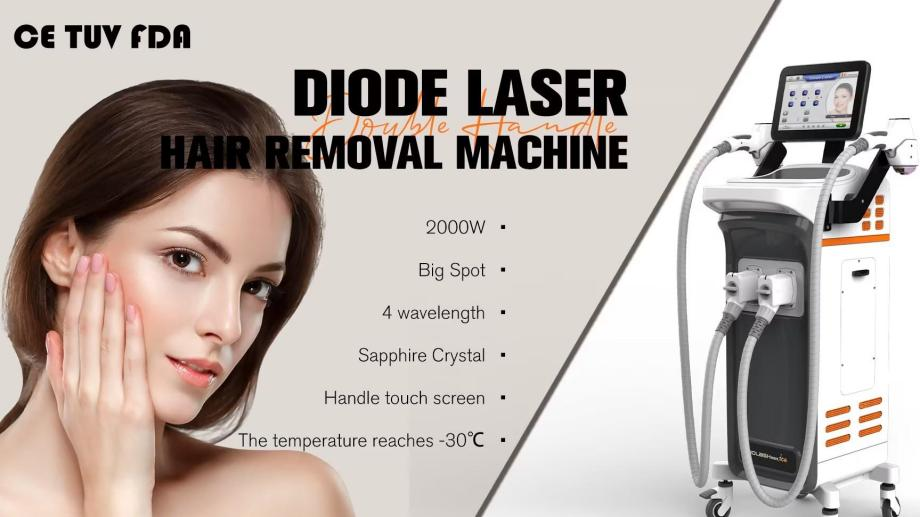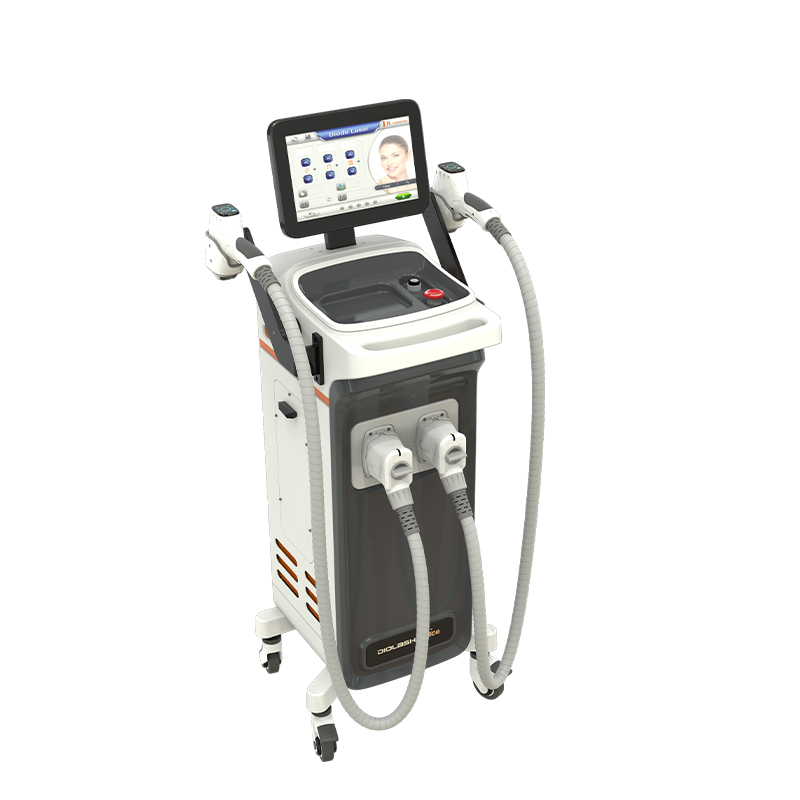Diode laser hair removal is a favored option for people looking for a lasting solution to hair. Thanks to progress, this approach specifically targets hair follicles, leading to reduced hair regrowth. Those contemplating this treatment often inquire about the number of sessions needed for results. Having a grasp of the factors that impact the session count can assist in establishing expectations, for both customers and professionals.

Understanding Diode Laser Hair Removal
What is Diode Laser Hair Removal?
Laser hair removal using technology that is a cosmetic treatment that harnesses the accuracy of lasers to eliminate hair follicles. It works well for skin tones and hair shades, making it a flexible choice for clients. By emitting a wavelength absorbed by the hair pigment, the laser hinders follicle regeneration without harming the skin nearby. This treatment aims to provide lasting results in reducing hair growth.
How Does Diode Laser Technology Work?
The science behind lasers revolves around pinpointing hair follicles with light energy. When this energy interacts with the follicle, it transforms into heat, ultimately hindering its ability to grow. Through the sessions, the treated follicles undergo a decrease in hair growth. An essential aspect of laser hair removal is its customization options as wavelength and pulse width enabling personalized treatments to suit requirements.
The Science Behind Diode Laser
Using lasers is based on a studied concept called photothermolysis, where certain light wavelengths damage the hair follicles but protect the nearby skin. This targeted absorption ensures the treatment is safe and efficient for skin tones. Different ideal wavelengths like 755nm, 808nm, 940nm and 1064nm effectively target hair follicles at varying depths in the skin.
Advantages of Using Diode Lasers for Hair Removal
Diode laser hair removal has a benefit in reducing discomfort when compared to hair removal methods. The technology includes cooling features to keep the treatment area comfortable during the session. Moreover, diode lasers provide treatment times needing sessions to get the results you want compared to other laser options, making it a more efficient choice.
Factors Affecting the Number of Sessions
Hair and Skin Type
The number of appointments needed for diode laser hair removal can vary based on the persons hair and skin characteristics. People with hair tend to have better results with diode laser procedures because the difference in color between the hair and skin helps target the hair follicles effectively. On the hand individuals, with light colored hair might need more sessions to achieve similar outcomes.
Treatment Area
The location, on which the body undergoing treatment can also impact the number of sessions required. Regions with hair such as the underarms or bikini area usually need sessions compared to areas with thin hair like the face or arms. Additional differences in skin sensitivity and thickness in areas can affect how well the treatment works and determine the number of sessions needed.
Hair Growth Cycle
Understanding the hair growth cycle is essential in determining the appropriate number of sessions for effective treatment. Hair grows in distinct phases: anagen (growth phase), catagen (transitional phase), and telogen (resting phase). Diode laser hair removal is the most effective during the anagen phase when hair is actively growing. Since not all hair is in the same growth phase at any given time, multiple sessions are necessary to effectively target hair during its growth phase.
Individual Response to Treatment
Individual responses to diode laser hair removal can vary greatly based on personal biology. Factors such as hormonal fluctuations, genetics, and overall health can impact how hair responds to treatment. Some clients may find that their hair regrowth is slower and less dense, which may lead to a reduced number of required sessions, while others might need additional treatments for optimal results. It’s important for practitioners to customize treatment plans to meet individual patient needs.
Typical Number of Sessions Required
General Guidelines
On average, clients can expect to undergo between three to six sessions of diode laser hair removal to achieve satisfactory results. This estimate can vary based on the aforementioned factors, including skin and hair type, the treatment area, and individual responses. Typically, sessions are spaced out every four to six weeks to allow hair to progress into the anagen phase for maximum efficacy.
Variations Based on Different Body Areas
The number of sessions required can also change depending on the specific area treated. For example, areas like the legs or back which have denser hair might necessitate a larger number of sessions compared to areas like the upper lip or chin. Generally, the lower leg may require approximately six sessions, while facial areas can see effective results in fewer sessions due to the finer nature of the hair. Understanding these nuances helps users set realistic expectations and plan effectively for their treatment.
In conclusion, while the average number of sessions required for diode laser hair removal varies from individual to individual, most patients experience significant improvement within a few sessions. Consulting with a medical professional who specializes in laser treatments will provide patients with an effective treatment plan tailored to their needs. Whether for aesthetic reasons or personal comfort, diode laser hair removal remains a leading choice for managing unwanted hair.
Benefits of Multiple Sessions
Increased Effectiveness Over Time
The efficacy of diode laser hair removal increases significantly with multiple sessions. During an initial session, only the actively growing hair (in the anagen phase) is effectively targeted; thus, subsequent sessions play a crucial role in capturing hair that may have been in dormant growth phases during previous treatments. As clients continue their sessions, they often notice a marked decrease in hair density and visible regrowth, contributing to long-lasting results. This cumulative effect is essential as it maximizes the potential for hair follicle damage, encouraging a more permanent reduction in hair growth.
Long-term Results and Maintenance
Reduction in Hair Density
Over time, multiple sessions of diode laser hair removal led to a noticeable reduction in hair density. Patients often report that hair regrowth becomes less dense and finer after each session, which enhances the overall appearance of the skin. This reduction in hair density is not only effective in lessening the need for frequent maintenance appointments but can also contribute to improved skin texture and hygiene. Continuous treatments ensure that the laser can impact follicles at various stages of their growth cycle, ultimately leading to a significant decline in hair follicle activity.
Smooth Skin Texture
Long-term results from multiple diode laser hair removal sessions also extend to skin texture. With reduced hair density, there is consequently less irritation from shaving or waxing, leading to a smoother, softer skin surface. As hair follicles become disabled, patients may experience a greater reduction in issues such as ingrown hairs, which are often common with alternative hair removal methods. Enhanced skin texture combined with fewer hair follicles not only results in aesthetic benefits but also contributes positively to patient satisfaction and self-esteem.
Nubway Diode Laser Solutions
Overview of Nubway’s Products
Nubway offers a range of diode laser hair removal products designed with cutting-edge technology to provide effective and painless treatments. These devices are built to leverage the latest innovations in hair removal, ensuring that practitioners can deliver optimal results for their clients. Nubway’s machines are noted for their ability to emit various wavelengths, including 755nm, 808nm, 940nm, and 1064nm, allowing for customized treatments based on individual patient needs. This versatility helps to address a diverse clientele, accommodating different hair and skin types effectively.
Features and Technology Integrated in Nubway’s Devices
Nubway’s diode laser hair removal systems feature state-of-the-art technology, such as high power outputs and ultra-fast treatment frequencies. With advanced in-built cooling systems, these devices operate at lower temperatures, providing a comfortable experience while minimizing pain. The sapphire crystal contact surface also enhances the cooling effect, ensuring safety during treatment. Moreover, with warranties of up to 100 million shots, practitioners can rely on Nubway’s durable machines for long-term service and reliability.
User-Friendly Design and Safety Measures
User-friendly designs are a hallmark of Nubway’s diode laser products, enabling practitioners to deliver treatments with ease and efficiency. They come equipped with intuitive touch screens that streamline the setup process, making it simpler to adjust settings based on individual treatment requirements. Additionally, Nubway’s commitment to safety is evident in its compliance with international certifications, including ISO13485, TUV medical CE, and US FDA certifications, ensuring that practitioners and clients can trust in the quality and safety of the treatments provided.
Preparing for Your Diode Laser Treatment
Pre-Treatment Care Tips
Preparation for diode laser hair removal is essential to maximize treatment effectiveness and minimize any potential discomfort. Clients are often advised to avoid sun exposure and tanning beds for at least two weeks prior to their appointment, as tanned skin can absorb more heat and increase the risk of side effects. Additionally, clients should stop waxing, tweezing, or using depilatory creams a few weeks before treatment since the laser needs to target the hair follicle. A thorough consultation with a qualified practitioner is also critical to discuss any pre-existing conditions and to personalize the treatment plan.
What to Expect During the Procedure
During the diode laser hair removal procedure, clients can expect a brief but thorough treatment using the device, which will emit laser energy targeting the hair follicles. The session begins with a professional assessing the treatment area and ensuring proper parameters are set based on individual hair and skin types. Many Nubway devices are fitted with advanced cooling features, which help alleviate discomfort throughout the procedure, like CO2 Laser machine and Picosecond Laser machine. Clients may feel a slight sensation like a rubber band snapping, but overall, it remains a tolerable experience, especially when compared to other traditional hair removal methods. After treatment, clients will receive specific aftercare instructions to optimize results and comfort.
Post-Treatment Care and Follow-up Sessions
Immediate Aftercare Instructions
Following a diode laser hair removal session, clients are provided with specific aftercare instructions to enhance comfort and ensure the best possible results. It is essential to avoid sun exposure or tanning for at least two weeks post-treatment, as the skin may be more sensitive and prone to hyperpigmentation. Clients are also encouraged to moisturize the treated areas and avoid harsh skincare products that may irritate the skin in the days following their appointment. Additionally, applying soothing gels or aloe vera can help calm any temporary redness or swelling at the treatment site.
During the immediate aftercare period, patients should refrain from engaging in activities that may cause excessive sweating, such as vigorous exercise or hot baths for 24 to 48 hours. This is to prevent potential irritation and allow the treated hair follicles time to recover. It’s also advisable to avoid exfoliating the area or undergoing chemical peel treatments until the skin has healed completely. Following these guidelines can contribute significantly to the overall effectiveness of the treatment.
Scheduling Your Follow-Up Sessions
To get the outcomes it’s important to schedule follow-up sessions when undergoing diode laser hair removal treatments. Most professionals suggest spreading out the sessions every four to six weeks, giving the hair time to enter the anagen phase for results. The exact timing may differ depending on hair growth patterns and treatment zones, so having open discussions with your provider is crucial in determining the timetable. Following this schedule guarantees that all hair follicles receive treatment, improving the likelihood of achieving lasting hair reduction.
As clients go through their sessions, it’s important to assess and make changes as needed to customize treatments based on how their hair’s growing back. Keeping an eye on how the laser treatment’s working can guide us in adjusting pulse width, energy settings, for future sessions to improve the outcomes. Practitioners usually advise clients to keep tabs on any changes in hair thickness and feel, which helps in managing expectations, for each follow up appointment.
Frequently Asked Questions About Diode Laser Hair Removal
Common Concerns
Is it Safe?
Diode laser hair removal is considered a method when done by experts. Nubway equipment has been thoroughly. Meets health and safety standards, like ISO13485 TUV medical CE and US FDA certifications. Device cooling mechanisms help lessen any discomfort during the procedure ensuring a experience. Additionally, since the laser targets hair follicles, it minimizes impact on the surrounding skin lowering the chances of reactions.
Any Side Effects?
For example, with any beauty treatment diode laser hair removal might cause a side effects but they’re usually mild and short lived. Some common side effects include redness, swelling or slight discomfort in the treated areas. These effects typically go away within hours to a couple of days after treatment. It’s crucial for clients to talk to their practitioners about any concerns they have so that they can get advice, on how to deal with these side effects. Severe side effects are uncommon, especially when clients follow the protocols and care instructions.
Effectiveness Queries
Many people often wonder about the effectiveness of laser hair removal when it comes to achieving long term hair reduction. Although outcomes may differ for each individual, most people notice a decrease in hair thickness after their treatment sessions. By utilizing cutting edge technology like what Nubway provides, the precise targeting guarantees that a greater number of follicles receive treatment leading to possible results.
Customers should keep in mind that it usually takes sessions to get the results as mentioned before. Not just diode laser hair removal, but many other beauty techniques needs a certain course of treatment, such as HIFU. The overall impact of having treatments boosts the chances of achieving hair removal as follicles gradually lose their ability to grow hair over time. Keeping up with follow-up appointments and sticking to a treatment plan are crucial for ensuring that diode laser hair removal remains effective in the run, allowing people to enjoy hair-free skin for an extended period.






